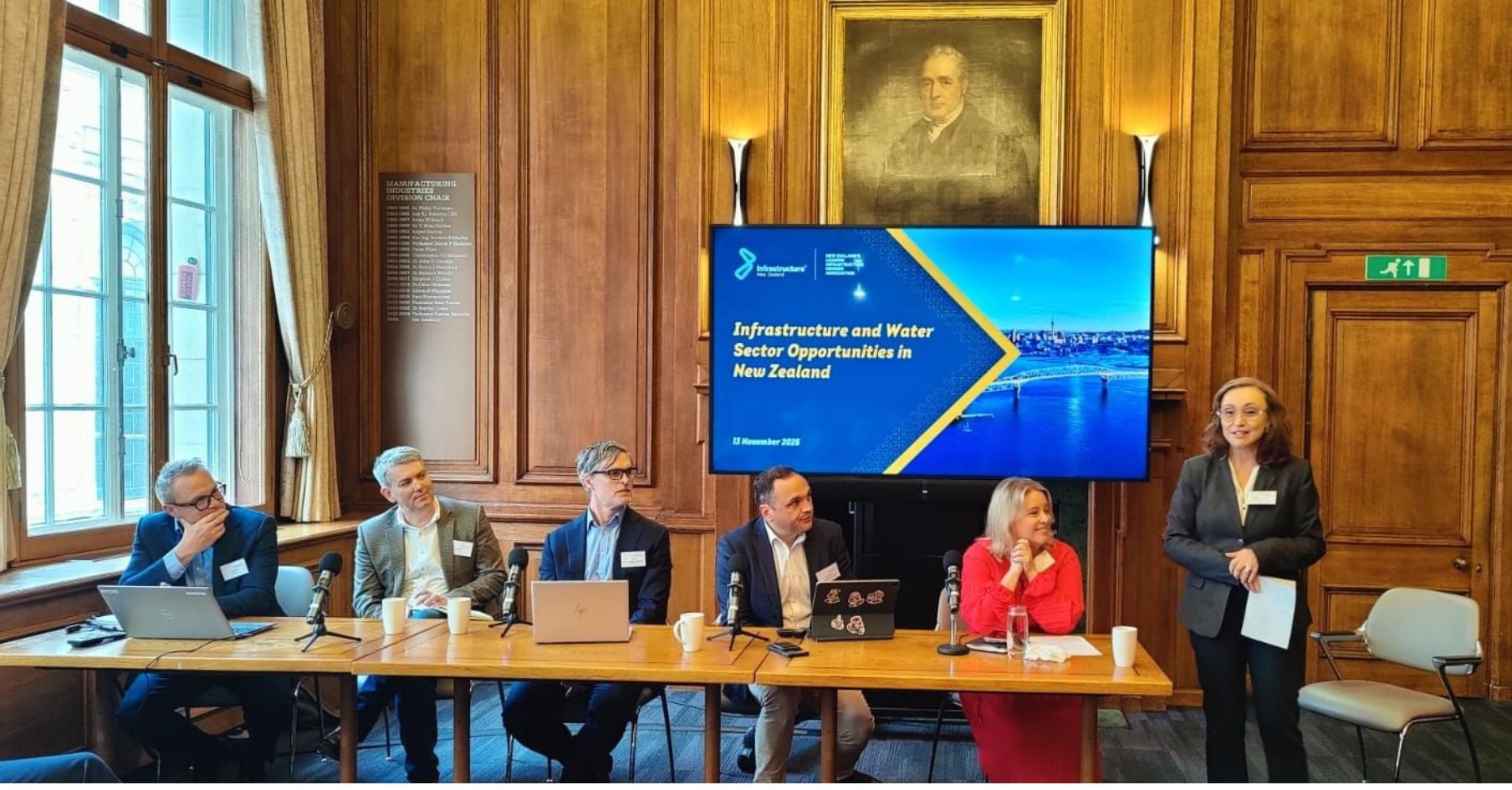During a time where water is increasingly regarded not just as an environmental concern but as a critical business priority, there is an accelerated need to bridge the gap between traditional water sector expertise and the industries that rely on this vital resource.
Our recent event, ran in partnership with the Global Summit Series and co-hosted by the D Group, sought to establish a cross-sectoral approach towards water resilience, focusing specifically on the best ways to address shared challenges such as water scarcity, wastewater management and evolving regulations.
We were pleased to welcome panellists Andy Roby, Senior Water Security Advisor, Foreign, Commonwealth and Development Office; Simon Ayley, Director of Strategic Growth Partnerships, Water Research Centre; Charlie Stratford, Head of Business and Partnership Development, UK Centre for Ecology and Hydrology and Jonathan Clark, Associate Director of Data Centres & Advanced Technology, Gleeds, who gave compelling insights on best practice approaches to increasing investment in water security both at home and around the world.
Below, we highlight our key takeaways of the challenges and opportunities associated with turning water risk into resilience.
The global water challenge is intensifying – and no one is exempt
Water risk is not exclusive to water companies and regulators – all water users are increasingly affected by the intensifying impacts of climate change and the ensuing consequences on our communities and businesses.
The effects of this can be felt around the world. In southern West Africa, deforestation has doubled thunderstorm frequency in some fast-growing coastal cities, whereas in Australia, the once "one-in-100-year" flood events are now occurring multiple times in recent years.
Despite these substantial changes, progress on water resilience is not keeping pace with climate change nor with the increased demand for water services, due to population growth, urban migration and economic growth.
Together, these trends underscore the urgent need for a more coordinated, cross-sectoral response to safeguard water security and ensure long-term resilience.
All sectors are linked by water
Water flows through all sectors, meaning challenges are often complex and interlinked.
If we regroup the UK Standard Industrial Classification (SIC) codes by relative water use intensity, we can start to see clear patterns emerge: agriculture, manufacturing, water supply and mining rank as high-intensity users, while sectors such as defence and education fall into the medium category. Water is therefore everyone’s business, and all sectors have a role to play in strengthening resilience.
Despite industry’s reliance on water, a review of 60 separate acts across the main SIC sections found:
• Just 7 with an explicit link to water
• 6 with an indirect link
• 47 with no explicit link
It’s worth noting Drought Plans & Emergency Water Supply Regulations govern water company responses, prioritising:
• Water for human consumption
• Essential public services (hospitals, care homes, emergency services)
• Critical National Infrastructure (energy, some food manufacturing - and now data centres)
For businesses who do not fall within the above, it is still crucial to assess water dependencies and develop a risk plan, both to safeguard operations and to enhance investability and growth potential. Water risks, including scarcity, flooding and pollution, can affect credit, market, liquidity and operational stability, and investors increasingly look for evidence that companies are prepared to manage these challenges – a topic we will examine further below.
Water risk is a financial risk
Water security depends as much on governance and investment as on infrastructure and technology. With recent extreme weather events around the globe highlighting the economic impact of water-based risk, such as last year’s flash floods in Spain, the financial sector is beginning to recognise the significance of this important connection. Central banks and insurers are increasingly integrating water-related risks into scenario planning and stress testing, acknowledging that floods, droughts and contamination can threaten not only ecosystems but also economic stability.
Yet awareness remains uneven: a revealing study mentioned by one of our panellists found that while nearly half of surveyed investors say they understand water resilience, fewer than 5% know how to assess it.
This calls for greater engagement with private finance to understand the risks and translate them into actionable strategies that drive investment towards resilience. By embedding water considerations into financial decision-making, the sector can help unlock the capital needed to future-proof businesses, communities and critical infrastructure.
The importance of promoting successful water stewardship
There are many existing collaborative initiatives that promote cross-sectoral water stewardship, both at home and internationally.
For example, the Rivers Trust ‘Replenish’ projects that take place across England make it simpler for businesses to invest in water. Supported by businesses from a range of sectors, each of these projects are utilising nature-based solutions to improve the quality and/or quantity of water. By creating a viable market for replenish credits from activities/interventions such as wetland creation, businesses can then purchase these credits to offset their own water usage within specific catchments.
Similarly, EnTrade at Wessex Water, which allows landholders to earn income from nature-based project, is a trading platform to encourage farms to deploy water carefully.
This growing intersection between business and water security highlights how collaborative, market-driven approaches can deliver tangible environmental and economic returns – and not just within the UK. On a global scale, the UK Government’s Just Transitions for Water Security (JTWS) programme draws together complimentary strategies to improve the capabilities of local and national policy makers to build climate resilience and water security. It aims to strengthen institutions, technical capacity and governance; build the market conditions and incentives for investment in water and ensure delivery of sustainable water stewardship. Targeting developing countries, this initiative is an example of how partnerships between industry, government and civil society can help ensure that water is managed responsibly, equitably and sustainably around the globe.
Amid accelerating climate challenges, it is deeply encouraging to see these initiatives in action, and here at BEI we believe their impact should be amplified to inspire broader adoption of water stewardship globally.
Data centres and water risk
Data centres are increasingly spotlighted for water risk as cooling demands rise with AI and high-performance computing. Traditional air cooling is often insufficient at high rack densities, driving adoption of liquid-based systems. Some liquid cooling, such as evaporative or adiabatic setups, can increase water use, but it’s worth noting that many modern approaches, such as immersion, direct-to-chip and cold-plate systems, operate in closed loops and use minimal or no water.
At the same time, data centres can supply waste heat to district-heating networks or local energy schemes, with AI workloads producing a consistent, high-value heat profile that can bolster local energy resilience. Water, energy, and infrastructure are increasingly interconnected, and investors and insurers are factoring these considerations into ESG assessments, asset valuation, and long-term operational resilience. This means that transparent reporting and proactive risk management are now essential for the financial viability of digital infrastructure.
Conclusion
The discussion points raised at our ‘Turning Water Risk into Resilience’ panel make it clear that water risk is no longer a niche concern. It is a universal challenge with far-reaching implications for communities, businesses and economies, and without action, more people are likely to suffer adverse effects. Building resilience requires coordinated, cross-sectoral efforts. While it is encouraging to see businesses increasingly prioritising water risks, more must be done to fully connect water security with sustainable economic growth.
Water risk is additionally not just an operational issue – it directly affects asset valuation, credit ratings and long-term investment returns. According to CDP, companies reported $301 billion in potential financial impacts from water-related risks, yet only a fraction of investors have frameworks to assess these exposures. This gap underscores the urgent need for better metrics, decision-support tools and blended finance models that can turn water resilience into a strategic advantage.
Building on these insights, BEI is convening a roundtable that will address these priorities head-on, bringing together technical expertise and financial leadership to explore how water risk can be quantified, integrated into ESG strategies and translated into investment opportunities. The discussion will inform a thought leadership piece for the finance community including practical guidance on water risk metrics, integration into ESG strategies and innovative financing models, linking BEI members’ expertise with the investment community’s need to understand and act on water resilience.







